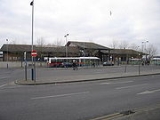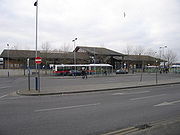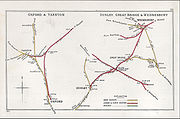
Oxford railway station
Encyclopedia
Oxford railway station is a mainline railway station serving the city of Oxford
, England
. It is about 1/2 mi west of the city centre, northwest of Frideswide Square
and the eastern end of Botley Road
, and on the line linking with . It is also on the line for trains between and Hereford
via . It is a starting point for fast and local trains to London Paddington and for local trains to Reading, Worcester and . The station is operated by First Great Western
, and also served by CrossCountry
and Chiltern Railways
trains.
 The Great Western Railway
The Great Western Railway
was first opened to Oxford on 12 June 1844 with a terminus station in what is now Western Road, Grandpont. In 1845 the Oxford and Rugby Railway began to build its line, starting from a junction at New Hinksey
0.75 miles (1.2 km) south of the GWR terminus. The junction was known as Millstream Junction, and was between the future sites of and , both or which were opened in 1908. The GWR took over the ORR while it was still being built, and opened the line as far as on 2 September 1850. For just over two years, trains from Oxford to Banbury started at Grandpont, and had to reverse at Millstream Junction in order to continue their journey.
The ORR line included a new through station in Park End Street
, so when this opened with the extension of the line from Banbury to Birmingham on 1 October 1852, the original Grandpont terminus was closed to passenger services. The old station at Grandpont became a goods depot, but was closed completely on 26 November 1872, the day that the broad gauge tracks were removed north of Didcot. The site of the station was then sold, as was the trackbed from Millstream Junction, some 66 chains (1,327.7 m) in length.
Major subsequent changes were removal of the last 7 foot gauge
tracks in 1872 and of the train shed
in 1890–1. The station was substantially rebuilt by the Western Region of British Railways
in 1971, further improvements being carried out during 1974 including the provision of a new travel centre, and the new main building and footbridge were added in 1990.
The station has always been busy. In addition to current services, formerly there were others over the Wycombe Railway
, Oxford, Witney and Fairford Railway
, and Blenheim and Woodstock Branch Line
. Through trains from the north to the Southern Railway
also typically changed locomotives at Oxford.
It was for a time known as Oxford General station to distinguish it from the London and North Western Railway
's terminus of the "Varsity Line
" to , which was adjacent and came under joint management in 1933. On 1 October 1951 British Rail
ways closed Rewley Road station to passengers and transferred its services to the former GWR station.
South of the station immediately west of the railway tracks is Osney Cemetery
, established in 1848 just before the current station site. Nearby is the site of the former Osney Abbey
.
In November 2009 it was announced that Oxford station would be expanded. A £10 million joint development between Network Rail and Oxfordshire County Council
would create a new platform on part of the station’s long-stay car park. The new platform (south of platform 1) would allow trains to arrive and depart from the same track and reduce the need for empty trains to be shunted around the station. Currently, in busy periods trains can be kept waiting outside of the station for a platform to become available.
A new covered footbridge would also be built over Botley Road
to link the station building with the new platform, replacing the existing footbridge to the car park. The new platform was to have been brought into use during 2011, and was to be part of the city and county councils' West End Area Action Plan for the western part of the city centre, which also considers other rail projects such as Evergreen 3 and the Paddington – Oxford electrification.
announced Project Evergreen 3, a proposal to construct a 0.25 miles (402.3 m) link between Bicester Town and the Chiltern Main Line
, to allow a new Oxford to London Marylebone service to run via Bicester Town and . The single line between Bicester Town and Wolvercote Tunnel will be doubled and a new station will be built at . If the scheme is approved, services may start in 2013.
The scheme also includes two new platforms at Oxford station, to be built on the site of the disused parcels depot. The new platforms would initially be five carriages in length, but provision will be made for them to be extended southwards to eight carriages.

Oxford
The city of Oxford is the county town of Oxfordshire, England. The city, made prominent by its medieval university, has a population of just under 165,000, with 153,900 living within the district boundary. It lies about 50 miles north-west of London. The rivers Cherwell and Thames run through...
, England
England
England is a country that is part of the United Kingdom. It shares land borders with Scotland to the north and Wales to the west; the Irish Sea is to the north west, the Celtic Sea to the south west, with the North Sea to the east and the English Channel to the south separating it from continental...
. It is about 1/2 mi west of the city centre, northwest of Frideswide Square
Frideswide Square
Frideswide Square is a square to the west of central Oxford, England. The square is named after the patron saint of Oxford, St Frideswide.The "square" is actually triangular in shape. Immediately to the north, the modern Saïd Business School of Oxford University dominates the square, established in...
and the eastern end of Botley Road
Botley Road
Botley Road is the main arterial road into Oxford, England from the west. It stretches between Botley, on the Oxford Ring Road to the west of the city, and Frideswide Square at the junction with Oxford railway station, close to central Oxford....
, and on the line linking with . It is also on the line for trains between and Hereford
Hereford railway station
Hereford railway station serves the city of Hereford, England. Managed by Arriva Trains Wales, it lies on the Welsh Marches Line between Leominster and Abergavenny and is the western terminus of the Cotswold Line.The station has four platforms...
via . It is a starting point for fast and local trains to London Paddington and for local trains to Reading, Worcester and . The station is operated by First Great Western
First Great Western
First Great Western is the operating name of First Greater Western Ltd, a British train operating company owned by FirstGroup that serves Greater London, the South East, South West and West Midlands regions of England, and South Wales....
, and also served by CrossCountry
CrossCountry
CrossCountry is the brand name of XC Trains Ltd., a British train operating company owned by Arriva...
and Chiltern Railways
Chiltern Railways
Chiltern Railways is a British train operating company. It was set up at the privatisation of British Rail in 1996, and operates local passenger trains from Marylebone station in London to Aylesbury and main-line trains on the Chiltern Main Line to Birmingham Snow Hill with its associated branches...
trains.
History

Great Western Railway
The Great Western Railway was a British railway company that linked London with the south-west and west of England and most of Wales. It was founded in 1833, received its enabling Act of Parliament in 1835 and ran its first trains in 1838...
was first opened to Oxford on 12 June 1844 with a terminus station in what is now Western Road, Grandpont. In 1845 the Oxford and Rugby Railway began to build its line, starting from a junction at New Hinksey
New Hinksey
New Hinksey is a suburb in the south of the city of Oxford.-Geography:The suburb is west of the Abingdon Road . To the north is Grandpont and to the east, over Donnington Bridge, which crosses the River Thames, is Cowley...
0.75 miles (1.2 km) south of the GWR terminus. The junction was known as Millstream Junction, and was between the future sites of and , both or which were opened in 1908. The GWR took over the ORR while it was still being built, and opened the line as far as on 2 September 1850. For just over two years, trains from Oxford to Banbury started at Grandpont, and had to reverse at Millstream Junction in order to continue their journey.
The ORR line included a new through station in Park End Street
Park End Street
Park End Street is a street in central Oxford, England, to the west of the centre of the city, close to the railway station at its western end.-Location:...
, so when this opened with the extension of the line from Banbury to Birmingham on 1 October 1852, the original Grandpont terminus was closed to passenger services. The old station at Grandpont became a goods depot, but was closed completely on 26 November 1872, the day that the broad gauge tracks were removed north of Didcot. The site of the station was then sold, as was the trackbed from Millstream Junction, some 66 chains (1,327.7 m) in length.
Major subsequent changes were removal of the last 7 foot gauge
Rail gauge
Track gauge or rail gauge is the distance between the inner sides of the heads of the two load bearing rails that make up a single railway line. Sixty percent of the world's railways use a standard gauge of . Wider gauges are called broad gauge; smaller gauges, narrow gauge. Break-of-gauge refers...
tracks in 1872 and of the train shed
Train shed
A train shed is an adjacent building to a railway station where the tracks and platforms are covered by a roof. It is also known as an overall roof...
in 1890–1. The station was substantially rebuilt by the Western Region of British Railways
Western Region of British Railways
The Western Region was a region of British Railways from 1948. The region ceased to be an operating unit in its own right in the 1980s and was wound up at the end of 1992...
in 1971, further improvements being carried out during 1974 including the provision of a new travel centre, and the new main building and footbridge were added in 1990.
The station has always been busy. In addition to current services, formerly there were others over the Wycombe Railway
Wycombe Railway
The Wycombe Railway was a British railway between and that connected with the Great Western Railway at both ends; there was one branch, to .-History:The Wycombe Railway Company was incorporated by an act of Parliament passed in 1846...
, Oxford, Witney and Fairford Railway
Oxford, Witney and Fairford Railway
The Oxford, Witney and Fairford Railway was a single track railway line, long, in Oxfordshire and Gloucestershire.-The Witney Railway:In 1849 a branch line was proposed from the Oxford, Worcester and Wolverhampton Railway at Wilcote near Charlbury via North Leigh to Witney, but the route was...
, and Blenheim and Woodstock Branch Line
Blenheim and Woodstock Branch Line
The Blenheim and Woodstock Branch Line was a long railway branch line that ran from Kidlington railway station along the Cherwell Valley Line north to Shipton-on-Cherwell where the line branched off west past towards Woodstock....
. Through trains from the north to the Southern Railway
Southern Railway (Great Britain)
The Southern Railway was a British railway company established in the 1923 Grouping. It linked London with the Channel ports, South West England, South coast resorts and Kent...
also typically changed locomotives at Oxford.
It was for a time known as Oxford General station to distinguish it from the London and North Western Railway
London and North Western Railway
The London and North Western Railway was a British railway company between 1846 and 1922. It was created by the merger of three companies – the Grand Junction Railway, the London and Birmingham Railway and the Manchester and Birmingham Railway...
's terminus of the "Varsity Line
Varsity Line
The Varsity Line is an informal name for the railway route that formerly linked the English university cities of Oxford and Cambridge, operated successively by the London and North Western Railway, the London, Midland and Scottish Railway, and British Railways...
" to , which was adjacent and came under joint management in 1933. On 1 October 1951 British Rail
British Rail
British Railways , which from 1965 traded as British Rail, was the operator of most of the rail transport in Great Britain between 1948 and 1997. It was formed from the nationalisation of the "Big Four" British railway companies and lasted until the gradual privatisation of British Rail, in stages...
ways closed Rewley Road station to passengers and transferred its services to the former GWR station.
South of the station immediately west of the railway tracks is Osney Cemetery
Osney Cemetery
Osney Cemetery is a disused Church of England cemetery in Osney, west Oxford, England. It is in Mill Street south of Botley Road and near the site of Osney Abbey. It borders the Cherwell Valley Line railway a short distance south of Oxford railway station....
, established in 1848 just before the current station site. Nearby is the site of the former Osney Abbey
Osney Abbey
Osney Abbey or Oseney Abbey, later Osney Cathedral, was a house of Augustinian canons at Osney in Oxfordshire. The site is south of the modern Botley Road, down Mill Street by Osney Cemetery, next to the railway line just south of Oxford station. It was founded as a priory in 1129, becoming an...
.
Further expansion
Passenger traffic at Oxford is growing rapidly. In the seven years 2003–10 the number of passengers using the station increased by 49%.In November 2009 it was announced that Oxford station would be expanded. A £10 million joint development between Network Rail and Oxfordshire County Council
Oxfordshire County Council
Oxfordshire County Council, established in 1889, is the county council, or upper-tier local authority, for the non-metropolitan county of Oxfordshire, in the South East of England, an elected body responsible for the most strategic local government services in the county.-History:County Councils...
would create a new platform on part of the station’s long-stay car park. The new platform (south of platform 1) would allow trains to arrive and depart from the same track and reduce the need for empty trains to be shunted around the station. Currently, in busy periods trains can be kept waiting outside of the station for a platform to become available.
A new covered footbridge would also be built over Botley Road
Botley Road
Botley Road is the main arterial road into Oxford, England from the west. It stretches between Botley, on the Oxford Ring Road to the west of the city, and Frideswide Square at the junction with Oxford railway station, close to central Oxford....
to link the station building with the new platform, replacing the existing footbridge to the car park. The new platform was to have been brought into use during 2011, and was to be part of the city and county councils' West End Area Action Plan for the western part of the city centre, which also considers other rail projects such as Evergreen 3 and the Paddington – Oxford electrification.
Project Evergreen 3
In August 2008 Chiltern RailwaysChiltern Railways
Chiltern Railways is a British train operating company. It was set up at the privatisation of British Rail in 1996, and operates local passenger trains from Marylebone station in London to Aylesbury and main-line trains on the Chiltern Main Line to Birmingham Snow Hill with its associated branches...
announced Project Evergreen 3, a proposal to construct a 0.25 miles (402.3 m) link between Bicester Town and the Chiltern Main Line
Chiltern Main Line
The Chiltern Main Line is an inter-urban, regional and commuter railway, part of the British railway system. It links London and Birmingham on a 112-mile route via the towns of High Wycombe, Banbury, and Leamington Spa...
, to allow a new Oxford to London Marylebone service to run via Bicester Town and . The single line between Bicester Town and Wolvercote Tunnel will be doubled and a new station will be built at . If the scheme is approved, services may start in 2013.
The scheme also includes two new platforms at Oxford station, to be built on the site of the disused parcels depot. The new platforms would initially be five carriages in length, but provision will be made for them to be extended southwards to eight carriages.
Services


